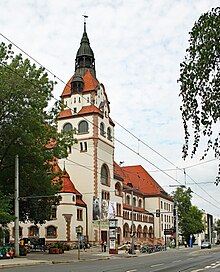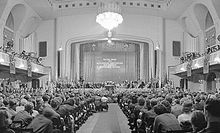Congress hall Leipzig
The Congress Hall Leipzig (written as a proper name according to the old spelling ) is an event building with several halls on Pfaffendorfer Straße in Leipzig, right next to the entrance to the Leipzig Zoo . Inaugurated in 1900 as the zoo's society center, the building served as one of Leipzig's most important event locations for more than eight decades. After a long vacancy, it was extensively renovated and rebuilt from 2001 to 2015.
building
The building of the society building with elements of Art Nouveau was designed by the Leipzig architect Heinrich Rust . With its length of 77 meters along the street, the wing facing the zoo and the crowning tower 50 meters high, the house is a dominant feature of urban development.
The house has several halls and rooms, which were named as follows at the time of its opening: Great Hall , White Hall , Terrace Hall (today Richard Wagner Hall), Pfauensaal (today Bachsaal), Lortzingsaal , Goethe Hall , Lessing and Leibniz Hall , Mendelssohn -Bartholdy room and bastion room . The ceiling in the foyer was considered to be one of the most important examples of Art Deco in Leipzig. The dance floor in the Great Hall was one of the largest so-called “swinging dance floors” in Europe, which, thanks to a multi-layer structure with cavities, enable “softer dancing”. The great hall also had an organ. A special post office was also available.
history
To the north of the confluence of the Parthe in the then course of the Pleiße , the Vorwerk Pfaffendorf had existed since the Middle Ages . After the reconstruction of the Vorwerk after the Battle of the Nations near Leipzig , the buildings served u. a. also the restaurant "Zum Pfaffendorfer Hof". Ernst Pinkert took over this restaurant in 1873 and opened his zoological garden in Leipzig on the meadow behind it on Whit Sunday 1878 . In 1899 he turned it into a stock corporation , to whose board and director he was appointed. A lively construction activity began, in the course of which the old manor buildings were demolished and buildings erected for the zoo, including the civil society house on Pfaffendorfer Strasse, today's congress hall, initiated by Leipzig merchants. The work on the society house was originally supposed to be completed on January 1, 1900, but after construction delays the opening did not take place until September 29, 1900.
It is often said that the building served as a military hospital in the First World War - but this cannot be proven and is considered to be rather unlikely. After the war, the house was again a social meeting place in Leipzig. During the Second World War, there was only minor damage, which was soon repaired. In 1947, the congress hall was reconstructed and rebuilt (tier widening, suspended ceiling, stage installation). This made it the most important society center in Leipzig.
From 1946 until the opening of the third Gewandhaus in 1981, the concerts of the Gewandhaus Orchestra under the direction of Franz Konwitschny , Václav Neumann and Kurt Masur took place in the Great Hall. Numerous international soloists made guest appearances. From 1946 to August 1989 the White Hall served as the venue for the first German-language children's theater - the Theater of the Young World .
Events of the most varied genres took place in the congress hall, including political congresses and sporting events in addition to those of the light muse. The opening ceremony of the DHfK took place in 1950 , the 1st German Culture Congress in 1951, the IV World Trade Union Congress in 1957, the wrestling tournament in honor of Werner Seelenbinder in 1959 and 1960 and the Leipzig Jazz Days every year since 1978 .
Historically significant is the protest in the congress hall on June 20, 1968 against the demolition of the university church , when a poster was rolled out in the final concert of the International Johann Sebastian Bach Competition calling for reconstruction. In September 1988 the building was closed by the building authorities except for the White Hall and was therefore no longer accessible to the public. On August 28, 1989, there was a fire in the stage building of the White Hall and as a result, on September 12, 1989, the Leipzig Congress Hall was completely closed.
In the course of the clearing out of the house, which was then initiated by the city, much of the original inventory that made the congress hall so charming disappeared.
Refurbishment 2001 to 2015
Initial initiatives to revitalize the house failed. On the Open Monument Day 2001, the citizens' initiative “Congress Hall Leipzig” was founded, which was able to push ahead with the renovation of the external facade in 2003 as part of the 125th anniversary of the zoo. On May 23, 2003 the zoo restaurant was opened in the Richard-Wagner-Saal . On December 19, 2006, members of the “Bachsaal Project Group” founded the “Kongreßhalle Leipzig” e. V. In 2007 the Krystallpalast Varieté moved into the Great Hall and used it until the summer of 2010.
In 2009 Zoo Leipzig GmbH became the client and the trade fair company became the economic operator of the congress hall. As part of the economic stimulus package II , 7.76 million euros were capitalized for the renovation in 2009. The first construction phase, to which the city contributed approx. 4.4 million euros as an investment surcharge, began in 2010. In total, around 30 million euros were invested in the project for which Leipzig Zoo acted as the client.
On September 29, 2010 - exactly 110 years after the opening of the Gesellschaftshaus - the foundation stone was laid. A new wing was created in the north wing of the building, which includes four new congress halls ( Telemann hall and Handel hall on the ground floor and Mahler hall and Schumann hall on the first floor) as well as the renovated neo-baroque Bach hall . Since December 2011, three halls in the basement have been available again. Parts of the south wing with the foyer of the great hall were also renovated; this area is to contain tourist information in the future.
In a second construction phase, the White Hall , built in 1925 , once a performance location for the Young World Theater and closed since a fire in 1989, was renovated. With the addition of a palm room, which was created on the site of the old predator house , the rooms will be used as a restaurant in the future.
In a third construction phase, the entire congress hall including the Art Nouveau Great Hall as well as four halls and two rooms on the first and second floors of the south wing were renovated until 2015 . The architect of the renovation was Gerd Heise .
The congress hall was reopened on May 29, 2015 with a ceremony with St. Thomas's Choir and Gewandhaus Quartet , which also marked the beginning of the “1000 Years of Leipzig” festival, followed by a public festival. The public musical inauguration of the Great Hall will take place on October 18, 2015. This means that a congress and conference center close to the city center with 15 halls and rooms with capacities for 10 to 1200 people is available. The operator of the complex is the Congress Center Leipzig of the Leipziger Messe .
organ
In the congress hall, as the new home of the Gewandhaus Orchestra, it should also be possible to perform organ works . Even before the reopening, the first discussions about the installation of a concert organ in the Great Hall took place on June 4, 1946. Three days later, the companies Jehmlich Orgelbau Dresden and Hermann Eule Orgelbau Bautzen were asked to submit an offer. Eule canceled just a few days later, so that the organ building company Jehmlich took over the order.
A decision was made for a two-part structure of the organ with the front pipes being arranged above the tier on both sides of the stage. To do this, the first left and right side windows of the hall including the skylights had to be closed. Assembly work began in August 1947. Due to the large number of events taking place, the work could not proceed as planned, and the handover date planned for December could not be kept. The total cost of the organ was RM 52,103.70 . Günther Ramin played the organ for the first time in the 14th Gewandhaus concert on February 12, 1948 , with works by Handel , Bach and Bruckner .
Due to the division of the organ into two widely separated places in the hall, its technical structure was complicated and the susceptibility to failure very high. Because of the numerous dance and entertainment events that took place, the organ became dirty extremely quickly, so that as early as 1959 "the once so beautiful instrument [...] fell into a catastrophic state due to irresponsible neglect." It became necessary to use the instrument in a complex manner before each use to look through and intone. For these reasons, the congress hall organ was only used for five concerts. It was played as a solo instrument at the Leipzig premiere of the organ concerto opus 50 by Rainer Kunad . The organ sounded for the last time on October 30th, 1980 with three organ sonatas by Mozart in the 7th Rights Concert of the Gewandhaus.
The organ disappeared after the fall of the Wall in the course of the above-mentioned clearing out; the gaming table was discovered in a church and brought back to the congress hall.
Disposition
|
|
|
||||||||||||||||||||||||||||||||||||||||||||||||||||||||||||||||||||||||||||||||||||||||||||||||||||||||
-
Couple
- Normal coupling: II / I, I / Pedal, II / Pedal
- Playing aids : 3-fold free preparation, register crescendo , tutti trigger, swell step for manual II, total tremolo for all registers ofmanual II, totaltriggerfor hand registration
- Remarks
Artists who performed in the Congress Hall (selection)
(in alphabetic order)
literature
- Mustafa Haikal , Thomas Nabert: Congress Hall Leipzig. The checkered history of a traditional society house. Pro Leipzig, Leipzig 2011, ISBN 978-3-936508-68-0 .
- Steffen Lieberwirth : An organ for the congress hall. In: The Gewandhaus Organs. Edition Peters, Leipzig 1986, ISBN 3-369-00220-5 , pp. 39-62.
- Falk Jaeger, Ed .: Kongresshalle am Zoo Leipzig - HPP Architects , JOVIS Verlag Berlin 2016, ISBN 978-3-86859-404-1
Web links
Individual evidence
- ↑ a b Haikal / Nabert: Congress Hall Leipzig.
- ^ Association "Kongreßhalle Leipzig" e. V.
- ↑ Wolfgang Hocquél: Leipzig. Architecture from the Romanesque to the present. Passage-Verlag, Leipzig 2004, ISBN 3-932900-54-5 , p. 143
- ^ A b Association "Kongreßhalle Leipzig" e. V .: History of the Congress Hall
- ↑ a b "Congress hall: search for traces is running" in: Leipziger Volkszeitung of April 27, 2011, see also http://www.kongresshalle-leipzig.com/presse/bilder/27.04.2011.jpg
- ↑ Message on lvz-online.de from December 1, 2011 ( memento of the original from December 9, 2011 in the Internet Archive ) Info: The archive link was automatically inserted and not yet checked. Please check the original and archive link according to the instructions and then remove this notice. , accessed December 2, 2011
- ↑ Andreas Tappert: After five years of construction, the congress hall shines in new splendor. In: Leipziger Volkszeitung , 30./31. May 2015, p. 15
- ↑ so the Leipzig lecturer and organist Hans Strobach in a petition ; see. Lieberwirth: The Gewandhaus organs. P. 61 f.
Coordinates: 51 ° 20 ′ 55.7 ″ N , 12 ° 22 ′ 16.3 ″ E



